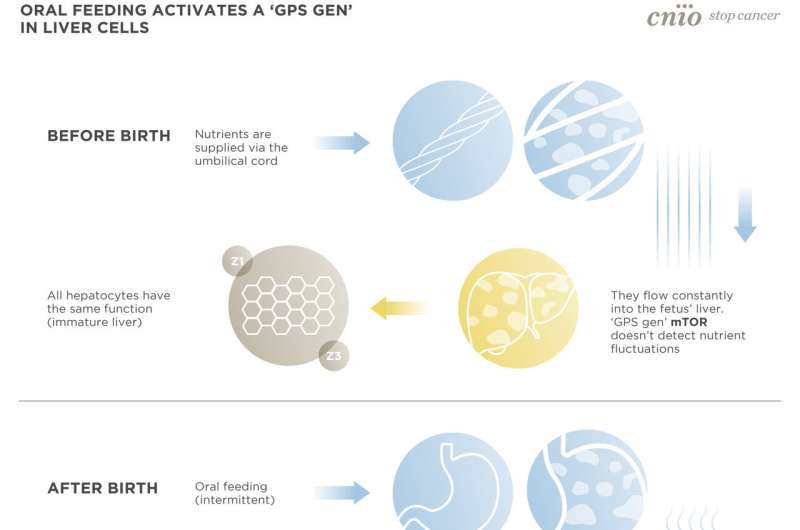This article has been reviewed according to Science X's editorial process and policies. Editors have highlighted the following attributes while ensuring the content's credibility:
fact-checked
trusted source
proofread
Intermittent food intake activates a 'GPS gene' in liver cells, thus completing the development of the liver after birth

In mammals, the liver detects the body's energy demand at any given moment and mobilizes nutrient reserves to meet it. It is a vital function that is subdivided into multiple tasks: from releasing glucose into the blood when the hormone insulin alerts about a need for energy, to synthesizing essential fats or proteins. These tasks fall to the hepatic cells, the hepatocytes, which take care of one or the other depending on their spatial position in the liver.
Until now, it was not clear how hepatocytes were assigned tasks related to their localization. Researchers at the Spanish National Cancer Research Center (CNIO) have discovered that a gene, mTOR, is responsible for organizing the hepatocyte position map.
They also found that what triggers hepatocyte specialization is feeding after birth. The difference is marked by how nutrients reach the organism before and after birth: with no interruptions through the umbilical cord in one case, or in an intermittent fashion –when eating– in the other. The alternation of periods with and without available nutrients activates the mTOR gene and causes the hepatocytes to specialize, which completes the maturation of the liver.
The study, led by Alejo Efeyan, head of the Metabolism and Cell Signalling Group, is published in Nature Communications.
"The mTOR gene works like a GPS, telling each liver cell what to do according to the place it occupies," explains first author Ana Belén Plata Gómez. "mTOR would act like an orchestra conductor in the liver, organizing the different musical components into sections to create a coordinated (tuned) melody of metabolic functions."
A precise position in a hexagon
Hepatocytes are arranged in the liver forming tiny three-dimensional hexagons of about 15 concentric layers of cells. The position it occupies in the hexagon is what determines the function of each hepatocyte.
"The order of hepatocytes is already established when the liver is formed in utero, but at that time, before birth, all hepatocytes do the same thing because the supply of nutrients via the umbilical cord is constant," Efeyan explains. "Only after birth, when oral intake begins, which is intermittent, do fluctuations in that supply start to occur."
It makes then sense to coordinate the needs of the body with the resources that it receives, and also to start the spatial distribution of tasks.
This distribution is not random: "the hepatocytes that receive food, for example, perform functions that require more energy, such as producing glucose, and some fats and amino acids. But they are all highly coordinated and their functions are in many cases complementary, like in a factory production line," says Efeyan.
Looking for the consequences of a sedentary lifestyle
The finding has been a surprise that emerged in the course of another investigation. The team was studying liver maturation to observe the consequences of the sedentary lifestyle and overeating characteristic to today's society, where the body receives nutrients all the time and produces a lot of insulin.
To reproduce this situation, they created genetically modified animal models for hepatocytes to detect constantly elevated levels of nutrients and hormones (insulin). And they observed that, after birth and with oral feeding (intermittent), the livers of these model animals never managed to diversify the tasks of the hepatocytes. They remained in a functionally immature state.
Plata Gómez, the lead author of the paper, understood then that this was because they were unable to detect the fluctuation of nutrients and insulin.
Comparison with parenteral feeding
Genetic modification in the model animals was performed in genes coordinated by the mTOR gene. It was already known that this gene intervenes in many functions related to energy expenditure and that it is activated through both food and hormones.
"By modifying mTOR, the spatial differentiation of those hepatocytes is lost," Plata Gómez explains. This gave them the clue: mTOR informs each liver cell of its function according to its location.
The team wanted to validate the extent to which this result had a real-life correlation, beyond the context of genetic manipulation. And they were able to do so thanks to the collaboration with a group of researchers from the University of Saint Louis (U.S.) who is researching parenteral feeding. In this kind of feeding, nutrients are supplied directly into a vein in a constant manner, without fluctuations. The U.S. group was studying this on newborn pigs.
The CNIO researchers found that in the livers of these animals spatial functions are not divided either.
More information: Hepatic nutrient and hormone signaling to mTORC1 instructs the postnatal metabolic zonation of the liver, Nature Communications (2024). DOI: 10.1038/s41467-024-46032-1
















